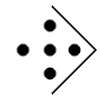"Draughts", as the game was called, was played the same way we play modern Checkers and was popular with women and lower-ranking members of Medieval society, who did not play Chess. Since Chess mimicked warfare, Draughts was considered a more ladylike alternative (Diehl and Donnelly 69-70). It is part of a family of games with varying rules and types of boards (Parlett 250-251). The version popular today was developed around the 12th century in France (Provenzo and Provenzo 196).
Checkers (Draughts)
Players: 2
Object: To capture all of your opponent's pieces.
Equipment: Checker board and two sets of 12 pieces in different colors (not provided here because Checkers sets are so commonly available, but if you want to improvise a set, draw the Checker board as described and cut 12 round pieces out of colored paper for each player)
I consulted Play It Again by Asterie Baker Provenzo and Eugene F. Provenzo, Jr. for the rules (pp. 196-199). The pieces are arranged as shown on a square board made up of smaller squares that alternate in color (light and dark, typically red and black), 8 squares by 8 squares, just like a common Chess board. There are 12 pieces of different colors for each side (typically red and black, although other colors are possible).
Moving: The players take turns moving their pieces, one at a time, starting with the player with the darker-colored pieces. The pieces move diagonally along the darker-colored squares, only one space at a time. The pieces can only move forward, toward your opponent's side, never back toward your own (unless a piece becomes a "king").
Capturing: To capture an opponent's piece, you must jump over it and land on the other side. If you are unable to land on the square immediately on the other side because it is occupied by another piece (either your own or your opponent's), you cannot make the capture. If after making a capture, you see that you can jump over and capture another piece, you can go ahead and make that capture as well. In fact, you can keep jumping and capturing pieces as many times as you want on a turn, provided that you do it with the same piece, landing on an empty space after each capture.
Kings: Once one of your pieces reaches your opponent's side of the board, you can place another piece on top of it (or flip it over, depending upon the design of your pieces, because some of them have pictures of crowns on the other side), making it a king. Although kings continue to move diagonally, like all other pieces, they can move either forward or backward on the board (toward your side or your opponent's).
Winning: The game ends when one player captures all of the opponent's pieces (or blocks them so that they cannot move) and wins. If the two players are finally left with only one piece each, and neither side can make a capture, the game ends in a draw.

